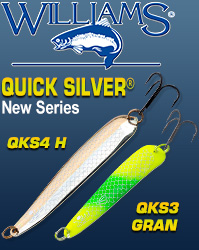ON THE STRAIGHT AND NARROW...History, Brook Trout Flow With Portage County Drainage Ditches
By Dick Ellis
Reader Note: When reading any of Dick Ellis’s 1200 Wisconsin journeys taken over two decades as a syndicated columnist, be sure to check current regulations when planning the trip yourself. The attached column offers a historical perspective of the brook trout fishing and drainage ditches within the Buena Vista Marsh and Portage County Drainage District. The story includes very unique Wisconsin history that dates back more than 100 years. For information on lodging, dining, entertainment or more outdoors in the Stevens Point Area call the Stevens Point Area CVB at 715-344-2556 or www.stevenspointarea.com or connect directly with Sara Brish at Sara@stevenspointarea.com.
The Buena Vista Marsh in southwest Portage County had given Steve Henske better August evenings of trout wrestling. The brookie that left the dark water of a deep hole to sting a flashing rooster tail, though, was worth the wait.
Henske brought the fish closer to surrender in the clearer shallows and rifted sand, the ultralight doubled over, the fish protesting the whole idea with a series of four beautiful boils. “Nice brookie,” he said quietly as I continued to work the camera from high on the bank. “In fact, 13-1/2 inches.”
My friend had taken even bigger brook trout here. And more fish. But Henske was on the straight and narrow of Ditch #2 within the Portage County Drainage District. No meandering trout stream here finding its own way across the pages of time. On the ditches, things can change, including the degree of fishing success. Henske comes to catch a unique piece of Wisconsin history, almost as much as another brookie or brown.
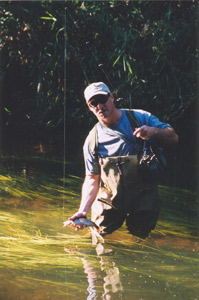 |
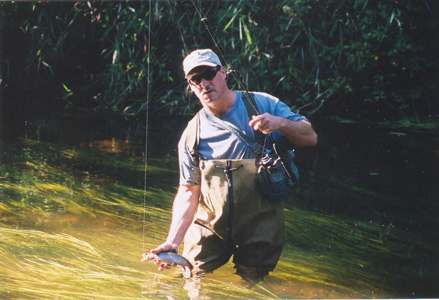 |
| Steve Henske lifts a 13-1/2 inch brook trout from Drainage Ditch #2 within the Buena Vista Marsh in Portage County. `That’s a nice brook trout in any stream,” said Fisheries Biologist Al Hauber. “In years of surveying Wisconsin streams, I could count the brook trout I’ve seen longer than 12 inches on two hands.” The 10 drainage ditches within the Marsh are under control of the Portage County Drainage District, have naturally reproducing populations of trout, and a compelling Wisconsin history dating back more than 100 years. | |
According to Ed Wade, Chairman of the Portage County Drainage District Commission, in the late 1800s Bradley University of Peoria Illinois would bring Students to the Buena Vista Marsh area for hands-on experiences in agriculture. Impressed with the fertile soil here, The University began to purchase parcels of land, develop and sell the property, then buy more. That is the reason, he said, that many of the farmhouses in the area today are similar appearing.
In 1903, Bradley University along with local property owners began the legal process of creating the Portage County Drainage District. The goal of the district and draining the marsh was to create more productive land with longer growing seasons.
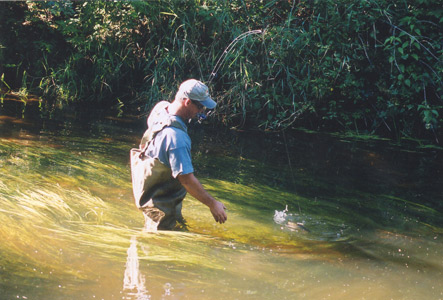
13-1/2 inch brook trout makes one final bid for escape before surrendering to Steve Henske on Drainage Ditch #2 within the Buena Vista Marsh in Portage County.
Shortly after 1903, with necessary easements purchased from private landowners, the University began to dredge seven original drainage ditches. The task was completed with a floating barge and mechanical shovel. The work crew lived on the barge.
Seven ditches proved inadequate to meet drainage goals, and three additional ditches placed between the original veins were dredged in 1913. The ditches are identified numerically, one through ten. But due to the two separate dredging projects and ditch placement, the ditches are not referenced chronologically on maps.
With time and erosion dictating the need for maintenance repairs by the depression years of the 1930s, the ditches were re-dredged. Wooden decks placed as road bridges during the original dredging allowed barge shovels, starting upstream, to lift the decks, dredge through the roadways, and reset the wooden bridge again.
With employment opportunities sorely lacking in the depression era, Wade said workers were hired to construct concrete dams on the ditches. The structures were designed to control underground peat fires and hopefully make the surrounding soil more agriculturally productive.
From the beginning, four of the ditches held a brook trout population by connection with natural streams. Buena Vista Creek meandered trough the marsh and became ditch #2 with dredging and straightening. Ditch #4 connected with Creek Four and Duck Creek. And Ditch #6 and Ditch #5 flowed into 10 Mile Creek and became the north and south branch of that fishery.
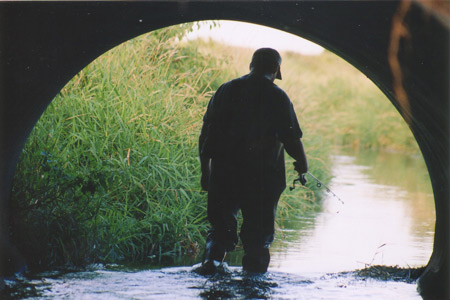 |
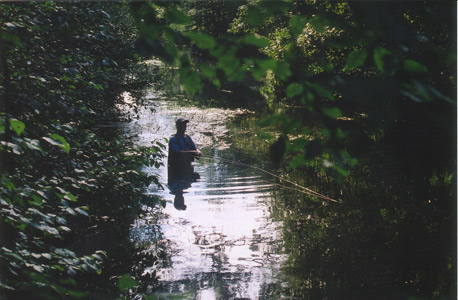 |
| Steve Henske works his way under the bridge and gravel road splitting the Buena Vista Marsh in Portage County to continue his search for brook trout on Ditch #2. Before the bridge, Henske was fishing wooded, private land that required permission to access. After the bridge, the ditch narrowed to just two feet in places and ran through the wide open grasslands of a Wisconsin prairie. Among the many birds and animals found within the marsh are prairie chickens. The 10 drainage ditches within the marsh are under the control of the Portage County Drainage District, have naturally reproducing populations of trout, and a compelling Wisconsin history dating back more than 100 years. | On the straight and narrow. Steve Henske’s Rooster Tail plops into the water on Drainage Ditch #2 as his search for brook trout in the Buena Vista Marsh of Portage County continues. The 10 drainage ditches within the marsh are under the control of the Portage County Drainage District, have naturally reproducing populations of trout, and a compelling Wisconsin history dating back more than 100 years. |
(The uniqueness of the ditches as trout water can be appreciated visually on page 19 of the DNR Trout Fishing Regulations and Guide, the outdoor bible of trout anglers. In the 2002 regulation, six of the ditches are categorized as trout water.)
The Potage County Drainage District has jurisdiction over 60,000 acres. Its primary purpose is to provide proper growing environment for the agricultural interests in the area. Because of that, dredging of the more than 100 miles of ditches periodically continues today, not always with the approval of some trout anglers.
Wade, of Bancroft, said he has one of the three positions on the Drainage Commission because he manages farming operations for OK Ray Family Farms of Plover . Business operations include cultivating acreage within the Buena Vista Marsh. And dredging the ditches, he said, actually benefits trout fishing.
“Lots of people think we destroy habitat, but stagnant water very rarely holds trout.” Wade said. “These ditches have fish because we dredge, keep the water flowing, and work closely with Trout Unlimited (TU) and the DNR to maintain a quality fishery. Our first responsibility is to eliminate water from the fields for the farmers. These lands were purchased with private funds. But we do maintain the ditches to enhance fishing too. And when we do have to impact the ditches, they recover quite well.”
DNR Fisheries Biologist Al Hauber concurs on both counts. Not only is dredging a district right, he said, the fishery remains in excellent shape with naturally reproducing populations of brookies. And browns that were initially established through stocking.
“People have to be aware that the drainage district has the right to do this ditch dredging,” he said. “And that fishing conditions may change. You could have very good fishing one year and it might change because of the maintenance dredging.”
Indicative of the quality fishery, Hauber said that 2001 state shocking surveys on Ditch #4 showed strong brook trout populations. Despite a heavy fish kill on that water discovered last year from aerial crop over-spraying. The spraying brought legal charges.
“We found 200 to 300 brook trout dead in the middle of the stream, but still found good numbers of brook trout with some big fish,” he said. “On August 16, 2001, we sampled 300 feet of Ditch Four and found 80 brook trout. Then we did another stretch and found 283 brook trout up to 10-inches. Those are good numbers, despite the kill.”
The fishery brings avid trout anglers like Steve Henske back annually. For the Stevens Point resident, every year since he enrolled at UW-Stevens Point in 1979. Personal introductions with good populations of brookies from nine to 13 inches, and browns in the 17-inch class will do that to a trout man.
“My biggest brookie here was 14-1/2 inches and I’ve seen friends take browns up to 20 inches,” he said. “The ditches seem to go in cycles. What’s good now might not be next year. You have to put your time in to find the right ditch. It’s a unique experience…trout fishing on the prairie.”



